The Remainder Theorem starts with an unnamed polynomial p(x), where "p(x)" just means "some polynomial p whose variable is x". Then the Theorem talks about dividing that polynomial by some linear factor x – a, where a is just some number. Then, as a result of the long polynomial division, you end up with some polynomial answer q(x) (the "q" standing for "the quotient polynomial") and some polynomial remainder r(x).
As a concrete example of p, a, q, and r, let's look at the polynomial p(x) = x3 – 7x – 6, and let's divide by the linear factor x – 4 (so a = 4):

You know, from long division of regular numbers, that your remainder (if there is one) has to be smaller than whatever you divided by. In polynomial terms, since we're dividing by a linear factor (that is, a factor in which the degree on x is just an understood "1"), then the remainder must be a constant value. That is, when you divide by "x – a", your remainder will just be some number.
The Remainder Theorem then points out the connection between division and multiplication. For instance, since 12 ÷ 3 = 4, then 4 × 3 = 12. If you get a remainder, you do the multiplication and then add the remainder back in. For instance, since 13 ÷ 5 = 2 R 3, then 13 = 5 × 2 + 3. This process works the same way with polynomials. That is:
(Technically, this "if - then" statement is the "Division Algorithm for Polynomials". But the Algorithm is the basis for the Remainder Theorem.)
In terms of our concrete example: Copyright © Elizabeth Stapel 2002-2011 All Rights Reserved
- Since (x^3 – 7x – 6) / (x – 4) = x2 + 4x + 9 with remainder 30,
then x3 – 7x – 6 = (x – 4) (x2 + 4x + 9) + 30.
- p(a) = (a – a)q(a) + r(a) = (0)q(a) + r(a) = 0 + r(a) = r(a)
- p(4) = (4 – 4)((4)2 + 4(4) + 9) + 30 = (0)(16 + 16 + 9) + 30 = 0 + 30 = 30
When you are dividing by a linear factor, you don't "have" to use long polynomial division; instead, you can use synthetic division, which is much quicker. In our example, we would get:

- Use the Remainder Theorem to evaluate f (x) = 6x3 – 5x2 + 4x – 17 at x = 3.
- First off, even though the Remainder Theorem refers to the polynomial and to long division and to restating the polynomial in terms of a quotient, a divisor, and a remainder, that's not actually what I'm meant to be doing. Instead, I'm supposed to be doing synthetic division, using "3" as the divisor:

- f (3) = 112.
- Using the Remainder Theorem, find the value of f (–5), for f (x) = 3x4 + 2x3 + 4x.
- I need to do the synthetic division, remembering to put zeroes in for the powers of x that are not included in the polynomial:

- f (–5) = 1605.
- Use the Remainder Theorem to determine whether x = 2 is a zero of
f (x) = 3x7 – x4 + 2x3 – 5x2 – 4
- For x = 2 to be a zero of f (x), then f (2) must evaluate to zero. In the context of the Remainder Theorem, this means that my remainder, when dividing by x = 2, must be zero:

- Use the Remainder Theorem to determine whether x = –4 is a solution of
x6 + 5x5 + 5x4 + 5x3 + 2x2 – 10x – 8 = 0
- For x = –4 to be a solution of f (x) = x6 + 5x5 + 5x4 + 5x3 + 2x2 – 10x – 8 = 0, it must be that f (–4) = 0. In the context of the Remainder Theorem, this means that the remainder, when dividing by x = –4, must be zero:
